Do you have a question about the Kenmore 110.42922200 and is the answer not in the manual?
Details DANGER, WARNING, and electrical shock hazards.
Explains how to identify the washer model and serial number.
Outlines tools, parts, and site requirements for washer installation.
Provides physical dimensions and various drain system options for installation.
Covers electrical supply needs, grounding, and steps to remove transport bolts.
Details how to connect water inlet hoses and secure the drain hose properly.
Guides on leveling the washer and final installation checks.
Steps to prepare the washer for pedestal installation, including uninstallation.
Overview of HE³ and HE³t washer features and conservation benefits.
Explains water flow through the dispenser and the washer's air circulation system.
Describes the washer's control panel, buttons, and the function of the pressure switch.
Details available options based on Kenmore High and Mid model ranges.
Explains the functionality and usage of specific wash cycle options.
Covers modifiers like spin speed, temperature settings, and the touch pad interface.
Details the function of the CCU, MCU, and the drive motor in washer operation.
Explains the roles of the pump motor, eco valve, and suspension system.
Describes the heating element, its relay, and the door lock/switch assembly.
Introduces component access and provides an overview of component locations by washer section.
Steps for accessing components within the washer's console, including removing the top and console.
Instructions on how to remove the washer door and access the door switch.
Steps for removing the front panel and boot, and guidance on their replacement.
Details on how to remove the detergent dispenser assembly and its motor.
Procedures for removing the main control box, pressure switch, and drive motor.
Instructions for accessing the Motor Control Unit and removing shock absorbers.
Steps for removing the heating element, temperature sensor, and the tub/drum assembly.
Further steps for disassembling the tub, including shock absorbers and pressure tube.
Procedures and special notes for reassembling and reinstalling the tub and heater element.
Identifies connector locations on the Central Control Unit for testing.
Details continuity and resistance checks for the pressure switch and temperature sensor.
Outlines testing procedures for solenoids, drain pump, and door lock switches.
Procedures for testing the heating element relay solenoid and the door switch.
Checks for the line filter and the dispenser motor continuity.
Specific tests for the pressure switch and heating element/relay.
Explains how the washer detects suds and the Kill-Foam routine procedure.
Details the door locking/unlocking process, including child security and unlock conditions.
Describes the washer's unbalance detection checks performed during spin cycles.
Explains error codes related to water detection, long drain, and temperature sensor issues.
Covers error codes for drive motor, MCU, overflow, and heat sink thermal trips.
Details errors related to communication, EEPROM, dispenser circuit, and suds lock.
Explains error codes related to the door lock and unlock mechanisms.
Guides on how to initiate and navigate the washer's diagnostic test program.
Specific resistance tests for the motor and water temperature sensor.
Addresses common problems like no power, failure to start, or not shutting off.
Solves issues related to overfilling, not draining, vibration, and incorrect temperatures.
Explains how to interpret the various elements within the cycle charts.
Provides details on pump operation and how cycle options are represented in charts.
Introduces spin profiles and details the LS1 spin cycle characteristics.
Illustrates the speed and time parameters for the LS2 spin cycle.
Details the parameters for LS3, LS4, and ES spin cycles.
Illustrates the electrical connections between all major washer components.
Provides instructions on how to manually release a locked washer door.
Details DANGER, WARNING, and electrical shock hazards.
Explains how to identify the washer model and serial number.
Outlines tools, parts, and site requirements for washer installation.
Provides physical dimensions and various drain system options for installation.
Covers electrical supply needs, grounding, and steps to remove transport bolts.
Details how to connect water inlet hoses and secure the drain hose properly.
Guides on leveling the washer and final installation checks.
Steps to prepare the washer for pedestal installation, including uninstallation.
Overview of HE³ and HE³t washer features and conservation benefits.
Explains water flow through the dispenser and the washer's air circulation system.
Describes the washer's control panel, buttons, and the function of the pressure switch.
Details available options based on Kenmore High and Mid model ranges.
Explains the functionality and usage of specific wash cycle options.
Covers modifiers like spin speed, temperature settings, and the touch pad interface.
Details the function of the CCU, MCU, and the drive motor in washer operation.
Explains the roles of the pump motor, eco valve, and suspension system.
Describes the heating element, its relay, and the door lock/switch assembly.
Introduces component access and provides an overview of component locations by washer section.
Steps for accessing components within the washer's console, including removing the top and console.
Instructions on how to remove the washer door and access the door switch.
Steps for removing the front panel and boot, and guidance on their replacement.
Details on how to remove the detergent dispenser assembly and its motor.
Procedures for removing the main control box, pressure switch, and drive motor.
Instructions for accessing the Motor Control Unit and removing shock absorbers.
Steps for removing the heating element, temperature sensor, and the tub/drum assembly.
Further steps for disassembling the tub, including shock absorbers and pressure tube.
Procedures and special notes for reassembling and reinstalling the tub and heater element.
Identifies connector locations on the Central Control Unit for testing.
Details continuity and resistance checks for the pressure switch and temperature sensor.
Outlines testing procedures for solenoids, drain pump, and door lock switches.
Procedures for testing the heating element relay solenoid and the door switch.
Checks for the line filter and the dispenser motor continuity.
Specific tests for the pressure switch and heating element/relay.
Explains how the washer detects suds and the Kill-Foam routine procedure.
Details the door locking/unlocking process, including child security and unlock conditions.
Describes the washer's unbalance detection checks performed during spin cycles.
Explains error codes related to water detection, long drain, and temperature sensor issues.
Covers error codes for drive motor, MCU, overflow, and heat sink thermal trips.
Details errors related to communication, EEPROM, dispenser circuit, and suds lock.
Explains error codes related to the door lock and unlock mechanisms.
Guides on how to initiate and navigate the washer's diagnostic test program.
Specific resistance tests for the motor and water temperature sensor.
Addresses common problems like no power, failure to start, or not shutting off.
Solves issues related to overfilling, not draining, vibration, and incorrect temperatures.
Explains how to interpret the various elements within the cycle charts.
Provides details on pump operation and how cycle options are represented in charts.
Introduces spin profiles and details the LS1 spin cycle characteristics.
Illustrates the speed and time parameters for the LS2 spin cycle.
Details the parameters for LS3, LS4, and ES spin cycles.
Illustrates the electrical connections between all major washer components.
Provides instructions on how to manually release a locked washer door.


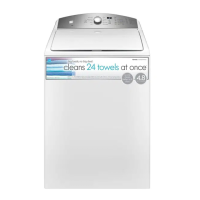
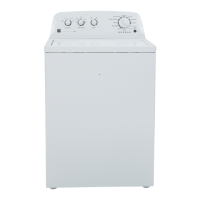
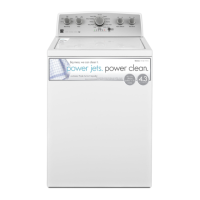
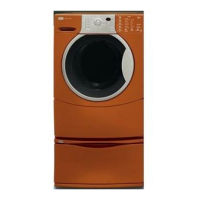



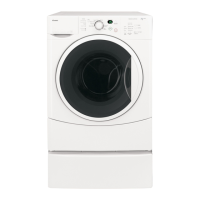


